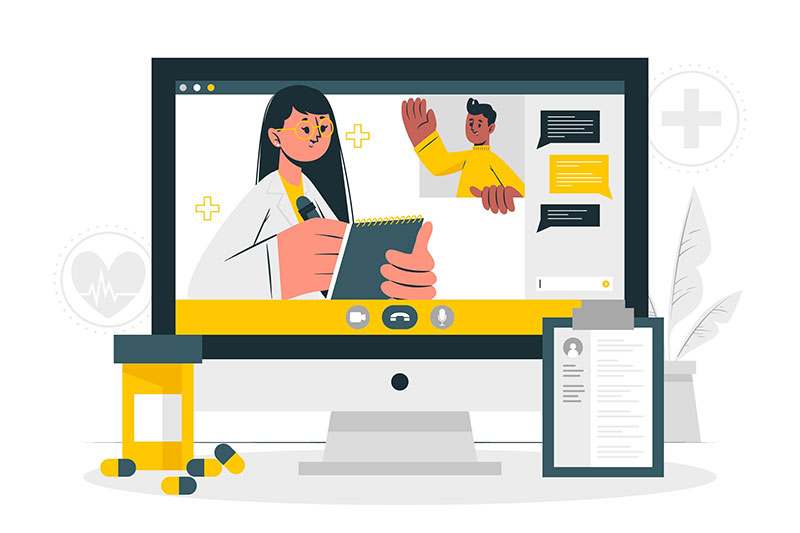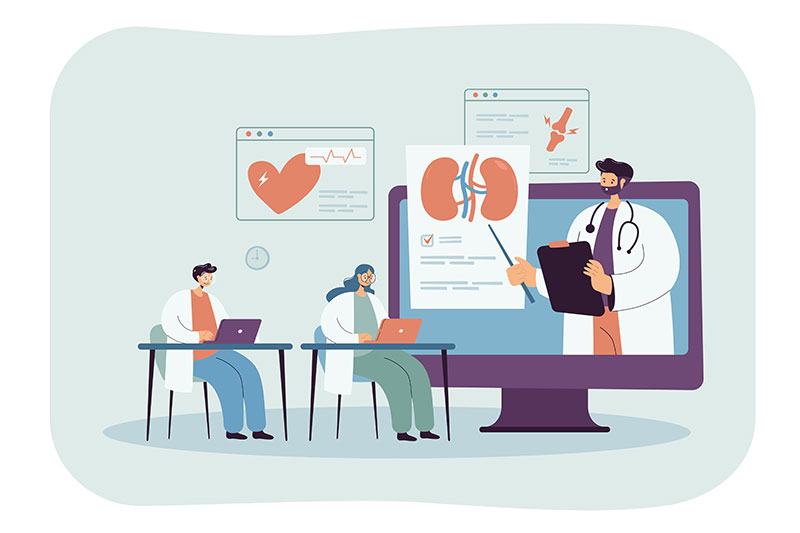7 Key Considerations to Create an Online Medical Coding Course
Medical coding is an essential aspect of medical care, and plenty of professionals learn this other “language” to support physicians and patients with diagnoses and billing.
This article will describe how to create an online Medical Coding Course that teaches budding medical coders all they need to know.

7 Things to Consider for Your Online Medical Coding Course
Creating an online medical coding course can be a challenge, but with the following tips, you’ll be able to make something that your students will love. Here are 7 things you need to consider.
1. Which Website Will You Use to Create Your Course?
The website you use to create your online medical coding course will impact your ability to customize it and your marketing potential.
Learning Management Systems (LMS) like Coursify.me are a good choice because course creation is quick and easy, you can completely customize your content, and the platform offers an optimized learning environment. This is a win-win situation for you and your students.
But no matter which platform you choose, make sure it comes with the features you need. Will it allow you to organize your curriculum into modules? Does it have integrations? Are there student management features, like a discussion forum? Can you get a custom domain?
Finally, make sure the platform gives you the ability to track your metrics. This will give you an idea of how your course is performing and how to adjust to improve the content.
– Whats is a Learning Management System
2. How Will You Introduce Core Content in Your Course?
Your course content is the most important part of every course, but it ain’t going to make it that far if you don’t provide a good introduction.
The introduction to your course should explain concepts you’ll include in the next sections.
The best online medical coding course will explain what code terminology you’re using, how you’ll assign codes and proper sequencing.
You could also explain how to identify the appropriate codes to assign for the condition they need.
If medical billing is involved, explain its need and HIPAA-compliant billing principles. Finally, explain the difference between diagnosis and producer coding, if applicable.
3. Which Code Terminology Will You Use?
In the United States, there are six official HIPAA-mandated code sets that are used for different needs. The code terminology you teach will depend on why the coder is taking your course.
Here are the 5 types of codes you could teach in your online medical coding course:
- ICD-10-CM: This is the most popular coding terminology. It has 69,000 code sets, each up to seven alphanumeric characters long, and they can describe anything that can make a patient sick, hurt, or die. ICD-10-CM is used to establish medical necessity.
- CPT: Includes 8,000 five-character alphanumeric codes. CPT is typically used to report outpatient services, but some physicians will use it in inpatient facilities.
- ICD-10-PCS: Includes 130,000 alphanumeric code sets and is mostly used for hospitals for surgical procedures and procedures performed in the emergency department.
- HCPCS Level II: Includes over 7,000 alphanumeric codes. Used by Medicaid, Medicare, and other providers who want to report procedures and bill for suppliers. Those on the medical coding career path may learn HCPCS Level II for outpatient surgery billing.
- NDC: Include a coding set of 10-13 alphanumeric character codes that allow suppliers, providers, and federal agents to track and report all drugs prescribed, sold, and used.
After deciding what coding terminology you’ll use, you’ll also have to briefly discuss coding modifiers. For example, CPT and HCPCS Level 11 have two-character alphanumeric modifiers that add clarity as to what part of the body you’re referring to or what service is being performed.
However, since ICD-10-CM is the most popular coding terminology, you’re likely to pick MS-DRG. These codes define attributes like diagnosis, procedures, sex, and discharge status for ICD-10-CM and ICD-10-PCS codes reported.
There is also APC, which describes what resources are used by the facility and supports the OPPS with payment reimbursement.
4. How Will You Present Coding Materials?
The beauty of online courses is that you can record yourself or a teacher showing students how to write medical codes.
It’s pretty common for medical coding teachers to record their screens, which would include slides of various types of code.
This is likely the best method, as it allows you or the teacher to show examples of how to properly write and use medical codes.
Consider getting someone to show their face on camera. A face-to-face request is 34x more successful than when it’s sent by email, proving that seeing a person’s face makes students more likely to complete a course. Humans simply value face-to-face interactions more.
– Meet the best free screen recorders
5. How Will You Teach Coding Principles?
There are many great ways to teach a course, but when it comes to teaching medical coding, the best directions to take include rote memorization and practical quizzes.
Let’s use ICD-10-CM as an example, as it’s the most popular code terminology currently.
While teaching students the right codes for the right circumstances, students should refer to the ICD-10-CM coding manual and follow along. For example, Chapter 1 in the ICD-10-CM coding manual is “Certain Infectious and Parasitic Diseases (A00-B99).” The teacher, either via slide or through video, would then ask the students to memorize these codes and test their knowledge.
Let’s say the teacher wanted to ask what code the student would use if the patient was admitted to that hospital with sepsis and acute renal failure secondary to sepsis. The student would then, either by a short answer or multiple choice, use the solution “A41.9, R65.20, N17.9.”
While you can set up your curriculum as you wish, the most organized way to do this is by separating each module by chapter.
Not only does this allow students to learn in small chunks, but it also helps them group codes by their intended purpose.
Ideally, you’ll have a quiz at the end of each section, which they have to pass to move on in your online medical coding course.
– How to become a online teacher
6. Will You Teach Supplementary Materials?
While teaching coding history, anatomy, and billing guidelines isn’t mandatory, it can really help their learning.
When a medical coder knows their anatomy, they’re better able to know where the problem is located and the subsequent code that shows where the patient was treated.
Billing guidelines are important for students to remain HIPAA compliant, whereas learning medical coding history code helps connect your students to what they’re learning.
Other material considerations include updates in coding terminology (perfect for those switching from ICD-9-CM to ICD-10-CM) and exam prep (for the CBCS or CPC certification).
7. How Will You Market Your Course Once It’s Complete?
As stated, the right platform can help you market your online medical coding course, but that isn’t the only way to promote it.
Unless you’re only using your course internally, you’ll need to think of ways to sell it online. But before you do that, you need to test if your course has a high market demand.
Fortunately, there is a demand for medical coders. It’s estimated that the market need will rise by 7% from 2021 to 2031. This makes it more likely your course will profit in the next decade.
After this step, you should do the following things to ensure your course sells:
- Pre-Sell: When you pre-sell a course, you’re selling it before you actually create it. This means customers will sign up for a pre-order (possibly enticing them with a discount). Make sure to ask for reviews for your course, as it will help you sell more. You need at least a title, topic, and course outline to reliably sell your course before release.
- Set Course Prices and Goals: Ask yourself how much you’ll spend on marketing campaigns, how price sensitive your customers are, and whether you have the authority to price higher. Then, set a goal. This will help you price your course. For example, if you want to make $100,000 and your course price is $250, you’ll need to sell 400 courses.
- Build a Landing Page: Your landing page is the place your customers should head to before they purchase your course. Fill it with testimonials, benefits, and discounts (if appropriate) for loyal customers. Remember that your landing page is supposed to answer all of their questions and convince them to take the final step: the purchase.
- Launch and Advertise: Use everything at your disposal to sell your online medical coding course. For example, you could run a webinar, use email marketing, go on podcasts, run ads, invest in SEO, utilize social media, and build a content marketing strategy. Juggle between sales content and value-based posts, as you don’t want to overwhelm your customers.
A great course won’t get far if people don’t know about it. That’s why it’s so important to build hype for your course and continue to do so well after it becomes live for your audience.
– How to launch online courses
Choose the Right Platform for your Online Medical Coding Course

Now that you already have a good idea of how to create your online medical coding course, it’s time to take advantage of the fact that demand is on the rise and get to work.
This will take time and dedication, but you only need to do it once. Then just publish to the right LMS and profit indefinitely.
With Coursify.me you can create your online school, personalize your page with a cover image, title, subtitle, logo, domain and integrate with your computer and Dropbox, Youtube and Vimeo accounts to upload content.
The management of enrollments, students and online payments are also done through the platform.
Present in more than 60 countries, Coursify.me is an intuitive and easy to use eLearning platform, being the perfect solution for you to set up your own business and launching online courses.
To learn more, visit our website, take a test and enjoy all the features of our platform to create and sell quality online courses.

